A Comprehensive Guide to Mushrooms
Mushrooms offer a fascinating culinary experience, yet identifying edible varieties amongst over 10,000 types requires caution and expertise; this guide will help!
Fungi represent a kingdom distinct from plants and animals, encompassing an incredible diversity of life forms, with mushrooms being the fruiting bodies of certain fungal species. These organisms play a vital ecological role as decomposers, breaking down organic matter and enriching the soil.
Exploring the world of fungi reveals over 10,000 types of mushrooms, ranging from microscopic molds to large, conspicuous structures. While many are inedible, and some are dangerously poisonous, a select few offer delightful culinary experiences. Understanding their biology and characteristics is crucial for safe foraging and appreciation. This guide aims to provide a foundational knowledge of these intriguing organisms;
Why Mushroom Identification is Crucial
Accurate mushroom identification is paramount due to the vast number of species, with only a small percentage being safely edible. Mistaking a poisonous mushroom for an edible one can lead to severe illness or even death, as highlighted by the presence of deadly varieties like the Death Cap.
The high chance of picking poisonous types necessitates caution and reliance on expert knowledge. Positive identification, utilizing multiple characteristics, is essential before consumption. This guide emphasizes the importance of careful observation and verification, promoting safe foraging practices and preventing potentially harmful consequences.
The Scale of Mushroom Diversity (Over 10,000 Species)
The fungal kingdom boasts an astonishing diversity, with over 10,000 identified mushroom species worldwide. This immense variety presents both opportunity and challenge for foragers and mycologists alike. While many species exist, only a small fraction possess distinctive, palatable flavors, making accurate identification crucial.
Exploring this vast landscape requires dedicated study and a cautious approach. The sheer number of types underscores the potential for misidentification, emphasizing the need for reliable resources and expert guidance when venturing into the world of wild mushrooms.

Popular Edible Mushroom Varieties
Discover delicious options like chanterelles, morels, oyster, shiitake, portobello, cremini, and white button mushrooms – each offering unique flavors and culinary uses!
Chanterelles: A Golden Delight
Chanterelles are renowned for their vibrant golden hue and fruity aroma, making them a prized find for foragers and chefs alike. These mushrooms boast a delicate, apricot-like flavor that enhances various dishes. Typically found growing on the ground near hardwood trees, chanterelles appear during the warmer months, often after rainfall.
Identifying chanterelles requires attention to detail; they feature forked, ridge-like gills that run down the stem, rather than true gills. Be cautious of false chanterelles, which can cause digestive upset. Their versatility shines in sautéed preparations, creamy sauces, and as an accompaniment to meats and poultry, truly elevating any meal.
Morels: The Honeycomb Mushrooms
Morels are highly sought-after mushrooms, instantly recognizable by their distinctive honeycomb-like caps. Their earthy, nutty flavor is unparalleled, making them a delicacy in gourmet cuisine. These elusive fungi typically emerge in the spring, often near elm, ash, and apple trees, particularly after forest fires.
Proper identification is crucial, as false morels exist and can be toxic. True morels are entirely hollow inside, while false morels have a cottony or chambered interior. Morels are best enjoyed sautéed in butter, stuffed with savory fillings, or added to creamy pasta dishes, offering a unique and unforgettable taste.
Oyster Mushrooms: Versatile and Easy to Grow
Oyster mushrooms are prized for their delicate flavor and velvety texture, making them incredibly versatile in the kitchen. They come in various colors – pearl, pink, and golden – and grow in shelf-like clusters on decaying wood. Notably, they are among the easiest mushrooms to cultivate at home, even for beginners.
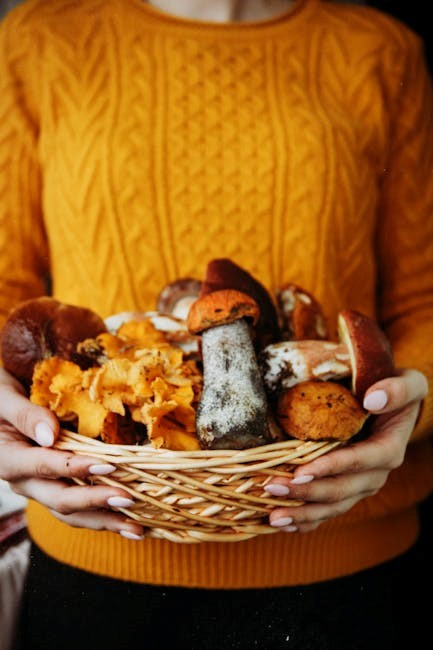
Oyster mushrooms can be sautéed, roasted, grilled, or added to soups and stir-fries. Their mild taste readily absorbs flavors, complementing a wide range of dishes. They are also a good source of nutrients, offering a healthy and delicious addition to any meal, readily available at farmers markets.
Shiitake Mushrooms: Umami Richness
Shiitake mushrooms, originating from East Asia, are renowned for their rich, savory umami flavor, adding depth to countless dishes. Traditionally grown on shii trees (hence the name), they now thrive on various hardwood logs. These mushrooms boast a meaty texture, even when cooked, making them a satisfying ingredient.
Shiitakes are incredibly versatile; they excel in stir-fries, soups, and sauces, and can even be enjoyed grilled or roasted. Beyond their culinary appeal, they are valued for potential health benefits. They are a popular find at local farmers markets, offering a unique flavor profile.
Portobello Mushrooms: The Meaty Mushroom
Portobello mushrooms are essentially mature cremini mushrooms, recognized for their large, open caps and substantial, meaty texture. This characteristic makes them a popular vegetarian substitute for meat in burgers and sandwiches, offering a satisfying and flavorful alternative. Their size allows for versatile culinary applications, from grilling and roasting to stuffing and marinating.
Portobellos possess a robust, earthy flavor that intensifies with cooking. They are readily available in most grocery stores, making them a convenient choice for home cooks. They are a delicious addition to pizza, pasta, and salads.
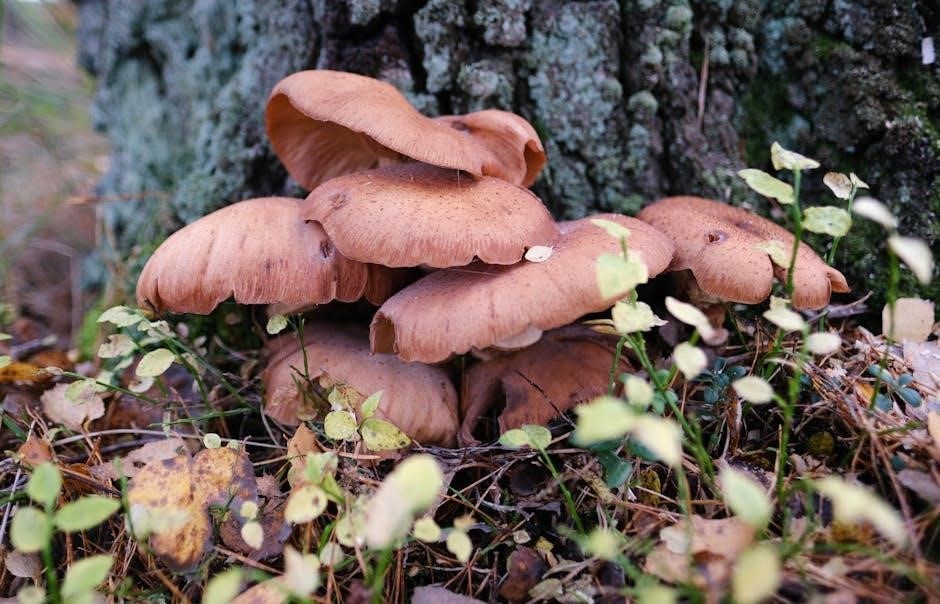
Cremini Mushrooms: A Common Culinary Choice
Cremini mushrooms, also known as baby bellas, are a widely available and versatile culinary staple. They represent a slightly more mature stage of the white button mushroom, boasting a firmer texture and a more developed, earthy flavor. This makes them ideal for a broad range of dishes, including sautéing, roasting, and adding to sauces.
Their mild flavor profile complements numerous ingredients, making them a popular choice for everyday cooking. Cremini mushrooms are frequently used in Italian and French cuisine, enhancing pizzas, pastas, and stews.
White Button Mushrooms: The Most Cultivated Type
White button mushrooms are the most commercially cultivated mushroom globally, prized for their mild flavor and affordability. These fungi are incredibly versatile in the kitchen, readily absorbing flavors from herbs, spices, and sauces. They are a staple ingredient in countless dishes, from simple omelets to elaborate casseroles.
Their accessibility and neutral taste make them an excellent starting point for those new to cooking with mushrooms. Commonly found in grocery stores year-round, they offer a convenient and nutritious addition to any meal.
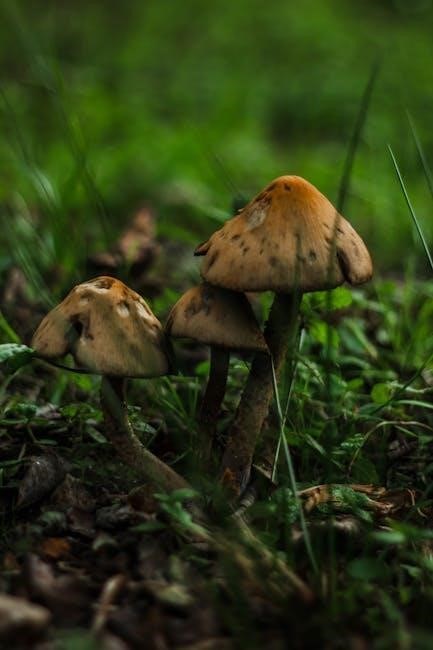
Identifying Mushrooms: Key Features
Accurate identification relies on observing cap shape, color, gill attachment, stem characteristics, habitat, and seasonality – crucial steps for safe foraging practices.
Cap Shape and Color
The mushroom cap exhibits remarkable diversity in shape and color, serving as a primary identification feature. Caps can be convex, flat, umbonate (with a central bump), or even depressed. Colors range widely, from vibrant reds and yellows to earthy browns and subtle creams.
However, color alone isn’t definitive, as it can vary with age and environmental conditions. Observing the cap’s surface texture – smooth, scaly, or sticky – is also important. Careful observation of these characteristics, combined with other features, is essential for accurate mushroom identification and avoiding potentially dangerous look-alikes.
Gill Attachment and Spore Print
Examining gill attachment – how the gills connect to the stem – is crucial. Attachments can be free, adnate (fused directly to the stem), decurrent (running down the stem), or notched. Equally important is the spore print, revealing the spore color.
To obtain a spore print, place the cap, gills down, on a dark and light surface overnight. Spore color is a key identifier; white, brown, pink, and black are common. These features, when considered together, provide valuable clues for accurate species identification, aiding in distinguishing edible mushrooms from their toxic counterparts.
Stem Characteristics (Presence of a Ring/Volva)
Stem features are vital for mushroom identification. Look closely for the presence of a ring, a remnant of the partial veil that protected the developing gills. A volva, a cup-like structure at the base of the stem, is another significant characteristic.
The presence or absence of these structures, along with stem texture and color, can differentiate between safe and dangerous species. Notably, many highly toxic mushrooms, like the Death Cap, possess a volva. Careful observation of these stem details is essential for responsible foraging and avoiding potentially fatal mistakes.
Habitat and Seasonality
Understanding where and when a mushroom grows is crucial for identification. Different species thrive in specific habitats – forests, meadows, or even on decaying wood. Some prefer coniferous woods, while others favor deciduous trees.
Seasonality also plays a key role; Morels, for example, are spring mushrooms, while Chanterelles typically appear in late summer and fall. Knowing the typical habitat and season narrows down possibilities, aiding accurate identification. However, variations in weather can shift fruiting times, so consistent observation is vital.
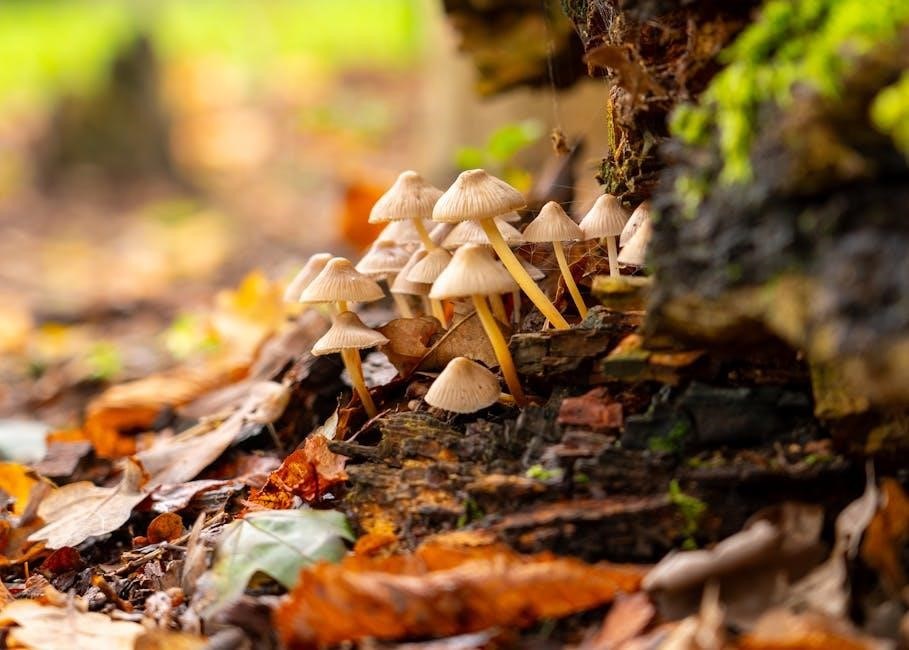
Dangerous Mushrooms: Look-Alikes to Avoid
Several poisonous mushrooms closely resemble edible ones, posing a significant risk. Accurate identification is paramount to avoid consuming deadly species like the Death Cap or Destroying Angel.
Death Cap (Amanita phalloides): A Deadly Threat
The Death Cap, Amanita phalloides, is arguably the most poisonous mushroom globally, responsible for the majority of fatal mushroom poisonings. It’s a deceptively attractive fungus, often pale greenish-yellow, with a smooth cap and white gills.
This mushroom contains amatoxins, potent toxins that initially cause gastrointestinal distress, followed by severe liver and kidney damage. Symptoms can be delayed for 6-24 hours, making treatment challenging.
Look-alikes include edible straw mushrooms and puffballs, increasing the risk of accidental ingestion. It typically grows near oak and beech trees during autumn. Never consume a mushroom unless you are 100% certain of its identification, and avoid any resembling the Death Cap.
Destroying Angel (Amanita virosa): Highly Toxic
The Destroying Angel, Amanita virosa, is another exceptionally dangerous mushroom, closely related to the Death Cap and equally lethal. It’s characterized by its pure white color – cap, gills, stem, and even the volva (sac-like structure at the base). This pristine appearance can be misleading, leading to misidentification.
Like the Death Cap, it contains amatoxins, causing delayed and devastating liver and kidney failure; Symptoms mimic severe gastroenteritis initially, masking the true danger.
Confusion often arises with edible white mushrooms. It thrives in woodlands, particularly under birch and oak trees, during summer and autumn. Absolute certainty in identification is crucial; avoid any all-white Amanita species.
Galerina marginata: Often Mistaken for Edible Species
Galerina marginata, commonly known as the Deadly Galerina, poses a significant threat due to its resemblance to edible mushrooms like Honey Mushrooms (Armillaria species). This small, brown mushroom contains the same deadly amatoxins as the Death Cap and Destroying Angel, causing severe liver damage.
It typically grows on decaying wood, particularly conifers, in damp forests. Identifying features include its rusty-brown spore print, a ring on the stem (which can be fragile and disappear), and a brownish cap that may have a slightly darker center.
Caution is paramount; never consume a small, brown mushroom growing on wood without expert identification.
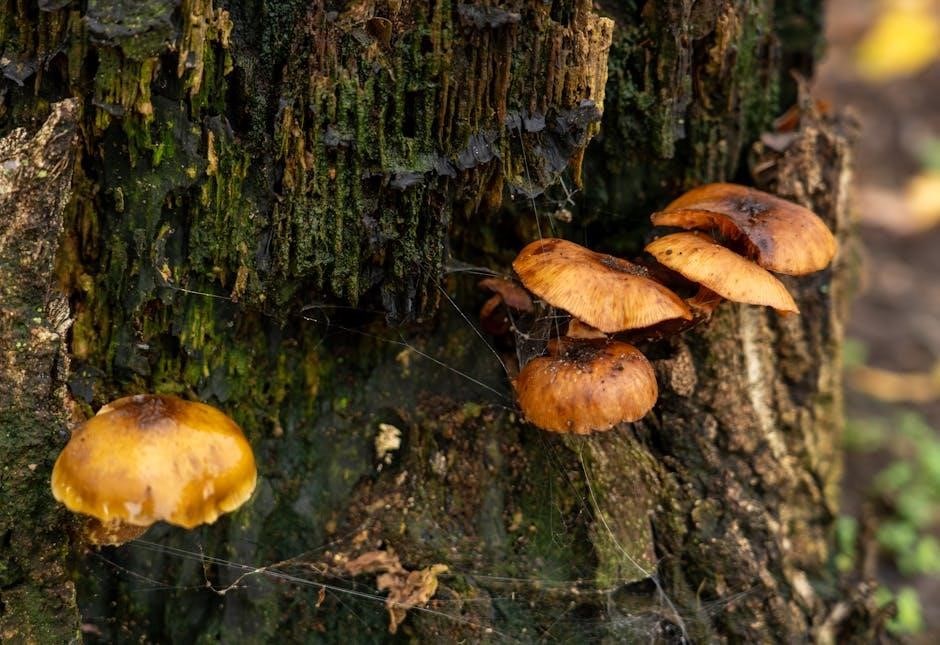
Safe Mushroom Foraging Practices
Foraging demands caution; always seek guidance from experts, prioritize positive identification, and employ sustainable harvesting techniques to protect fragile fungal ecosystems.
Foraging with an Expert
Embarking on mushroom foraging without proper knowledge can be perilous. Therefore, the most crucial safety measure is to learn from an experienced mycologist or local mushroom expert. They possess invaluable insights into local species, including identifying edible varieties and recognizing dangerous look-alikes.
An expert can demonstrate proper identification techniques, explain habitat preferences, and highlight potential hazards. Participating in guided forays provides hands-on learning and builds confidence. Remember, even seasoned foragers sometimes misidentify mushrooms, emphasizing the importance of a knowledgeable companion. Prioritize safety and learning – never consume a mushroom unless positively identified by a trusted expert.
Positive Identification is Essential
Before consuming any wild mushroom, absolute certainty regarding its identification is paramount. Misidentification can lead to severe illness or even death, as many poisonous species closely resemble edible ones. Relying on multiple identification features – cap shape, gill attachment, spore print, stem characteristics, and habitat – is crucial.
Cross-reference findings with reliable field guides and online resources, but never solely depend on a single source. If any doubt exists, discard the mushroom. Remember, “when in doubt, throw it out!” Prioritizing positive identification safeguards your health and ensures a safe and enjoyable foraging experience.
Harvesting Techniques: Minimizing Environmental Impact
Sustainable foraging practices are vital for preserving mushroom populations and the ecosystems they inhabit. Avoid disturbing the surrounding habitat; gently lift mushrooms instead of digging them up, preserving the mycelial network. Carry a basket or mesh bag to allow spore dispersal while transporting your harvest.
Only collect mature specimens, leaving younger ones to mature and reproduce. Never harvest all mushrooms from a single location, allowing for continued growth. Respect private property and obtain necessary permissions. Responsible harvesting ensures future generations can enjoy these natural treasures;

Mushroom Cultivation at Home
Growing mushrooms at home is achievable through log cultivation or convenient indoor kits, offering a rewarding experience and a fresh, sustainable food source.
Growing Oyster Mushrooms on Logs
Oyster mushrooms thrive on hardwood logs, like oak, maple, or poplar, making log cultivation a sustainable option. Begin by drilling holes into the logs, spaced several inches apart, and inserting mushroom spawn – typically sawdust or plug spawn – into these holes.
Seal the holes with wax to retain moisture and prevent contamination. Keep the logs shaded and moist, ideally in a humid environment. Fruiting typically occurs within six to twelve months, depending on the log type and environmental conditions.
Regularly monitor for mushroom development and harvest when caps are fully formed but before they release spores. This method provides a continuous yield for several years!
Indoor Mushroom Kits: A Beginner-Friendly Option
Indoor mushroom kits offer a simple entry point into mushroom cultivation, requiring minimal space and expertise. These kits typically contain a substrate inoculated with mushroom mycelium, ready to fruit. Simply follow the kit’s instructions, which usually involve misting the substrate regularly to maintain humidity and providing adequate ventilation.
Most kits will begin producing mushrooms within a week or two, offering a quick and rewarding experience. Oyster mushrooms are commonly found in these kits due to their fast growth rate and ease of cultivation.
Enjoy fresh, homegrown mushrooms with minimal effort!
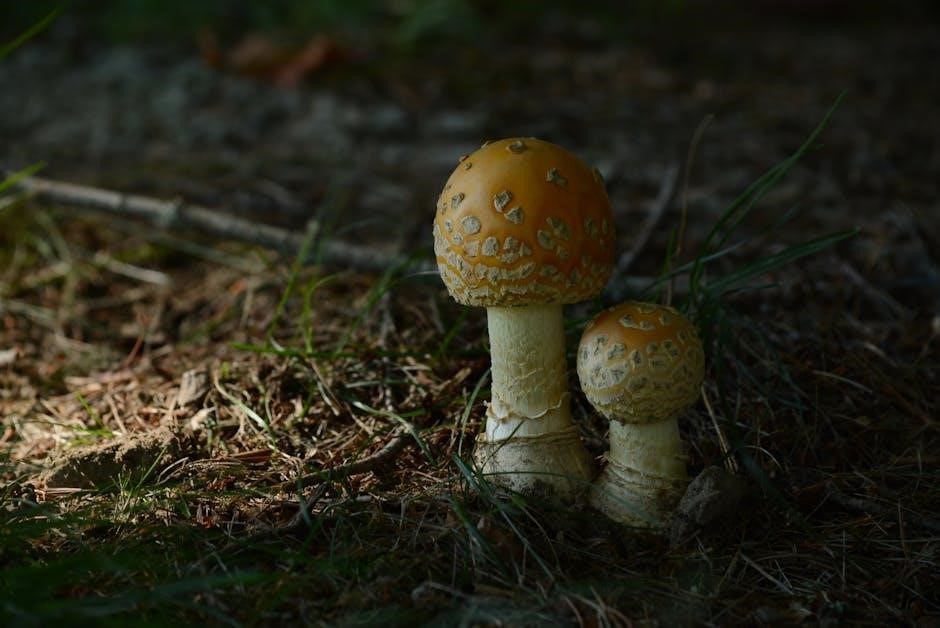
Nutritional Benefits of Mushrooms
Mushrooms are packed with essential vitamins and minerals, plus boast impressive antioxidant properties, contributing to overall health and well-being.
Vitamins and Minerals
Mushrooms are a surprisingly rich source of several essential vitamins and minerals, making them a valuable addition to a balanced diet. They notably contain B vitamins like riboflavin, niacin, and pantothenic acid, crucial for energy production and nervous system health.
Furthermore, mushrooms provide important minerals such as selenium, potassium, copper, and phosphorus. Selenium acts as an antioxidant and supports immune function, while potassium is vital for maintaining healthy blood pressure. Copper aids in iron absorption, and phosphorus is essential for bone health. The specific nutrient content can vary depending on the mushroom variety, but generally, they offer a beneficial nutritional profile.
Antioxidant Properties
Mushrooms are packed with potent antioxidants, compounds that help protect the body from damage caused by free radicals. These free radicals contribute to aging and various diseases. Mushrooms contain ergothioneine and glutathione, two particularly powerful antioxidants not commonly found in other foods.
Ergothioneine, in particular, is remarkably stable and can withstand cooking temperatures, retaining its beneficial effects. These antioxidants help neutralize harmful molecules, reducing oxidative stress and potentially lowering the risk of chronic illnesses. Regular consumption of mushrooms can contribute to overall health and well-being through these protective properties.

Culinary Uses of Mushrooms
Mushrooms elevate dishes like pizza, pasta, and salads with their unique flavors; they’re incredibly versatile in soups, stews, sauces, and as a savory side!
Mushrooms in Soups and Stews
Mushrooms impart a deeply savory, umami-rich flavor to both creamy and brothy soups and hearty stews. Their earthy notes complement a wide range of ingredients, from root vegetables and grains to meats and poultry.
Adding mushrooms early in the cooking process allows them to release their flavors, building a complex base for the dish. Varieties like shiitake and oyster mushrooms are particularly well-suited for soups, offering robust tastes. Portobellos and cremini mushrooms also work wonderfully, providing a meaty texture.
Consider pairing mushrooms with herbs like thyme or rosemary to enhance their earthy character. They truly transform simple soups and stews into comforting and flavorful meals.
Mushrooms as a Pizza Topping
Mushrooms elevate pizza from a simple comfort food to a gourmet delight, adding an earthy depth that complements the cheese and sauce beautifully. Their unique texture provides a satisfying contrast to the soft crust and melted mozzarella.
Cremini and white button mushrooms are popular choices for pizza, offering a mild flavor that appeals to many. However, more adventurous pizza lovers might opt for shiitake or oyster mushrooms for a more intense, umami-rich experience. Sautéing the mushrooms before adding them to the pizza prevents a soggy crust.
Pair mushrooms with ingredients like caramelized onions, roasted garlic, or Italian sausage for a truly exceptional pizza.
Sautéed Mushrooms as a Side Dish
Sautéed mushrooms represent a remarkably versatile and flavorful side dish, complementing a wide array of main courses. Their earthy notes and tender texture make them a delightful addition to any meal, from simple weeknight dinners to elegant gatherings.
Portobello, cremini, and shiitake mushrooms are excellent choices for sautéing, each offering a unique flavor profile. A simple preparation with butter, garlic, and herbs – like thyme or parsley – enhances their natural taste. Don’t overcrowd the pan; this ensures proper browning and prevents steaming.
Serve sautéed mushrooms alongside steak, chicken, or fish for a complete and satisfying meal.
Mushroom-Based Sauces and Gravies
Mushroom-based sauces and gravies elevate dishes with their rich, umami flavor and luxurious texture. They are incredibly versatile, pairing beautifully with meats, poultry, pasta, and vegetables, adding depth and complexity to any culinary creation.
Creamy mushroom sauce, often featuring varieties like shiitake or cremini, is a classic accompaniment to steak or chicken. A simple mushroom gravy, thickened with flour or cornstarch, enhances roasted meats and mashed potatoes. Utilizing mushroom stock intensifies the flavor profile.
Experiment with different mushroom types to create unique and unforgettable sauces!
